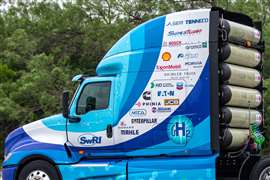Read this article in 中文 Français Deutsch Italiano Português Español
Challenges in fueling hydrogen trucks in extreme cold
03 June 2024
Canada’s Alberta Motor Transport Association has done research into operating hydrogen-diesel dual-fuel trucks and FCEVs in bitterly cold conditions. This story focuses on the fueling challenges it has uncovered.
The Alberta Motor Transport Association (AMTA) is a not-for-profit organization that represents over 75 percent of the more than 24,000 commercial transportation carriers across Alberta, Canada. While it supports education, training and member advocacy, it is also focused on research and innovation.
 Image: alphaspirit via Adobe Stock
Image: alphaspirit via Adobe Stock
“We desire to accelerate technologies that enhance safety, extend operational efficiencies or support environmental stewardship for the commercial transportation industry,” according to the AMTA website.
In a recent Mission Hydrogen webinar, AMTA reported on research into one such innovation: the long-distance use of hydrogen trucks in the province’s extreme cold weather conditions. This includes hydrogen-diesel dual-fuel vehicles as well as hydrogen fuel cell electric vehicles (FCEV).
According to webinar presenter Jamie King, who works in research and innovation for AMTA’s industry and advancement group and is AMTA’s subject matter expert regarding hydrogen trucks, the association has done trials with more than 20 carriers using Hydra Energy dual-fuel trucks, Hyzon FCEVs and Nikola FCEVs.
Regarding hydrogen-diesel dual-fuel technology in particular, King said one reason AMTA has focused on it is to help fleets with a relatively cost-effective transition to more sustainable on-highway solutions.
“A lot of fleets can’t afford to directly jump to fuel cell electric with the cost of investing in a brand-new vehicle,” she said. “And what hydrogen diesel dual fuel allows you to do is take your current fleet to end-of-life. In Canada, for approximately $60,000 to $70,000, you can retrofit your current truck to be diesel dual-fuel.”
Cold-Weather Operation
In performing its trials, AMTA was particularly interested in understanding the challenges unique to operating these vehicles in Canadian environments.
“One thing that’s become somewhat of a concern for us in Canada is a lot of the vehicles are produced in the U.S. and Europe,” King said. “The ones that are produced in the U.S. that we are getting — they typically are built for lighter loads, shorter distances and more mild temperatures.”
She added that as a result, AMTA looks to “Alberta-ize” the trucks they get from the U.S. and abroad.
“We do really consider the colder temperatures more so than the hotter temperatures,” King said. “Our Nikola trucks came from Arizona, where they actually have to take into consideration the hotter temperatures. They’re looking at plus 40°C (104°F), whereas we’re looking at minus 40°C (-40°F).”
According to King, one unique temperature-related challenge is fueling hydrogen trucks. Part of the issue is due to the purity required for FCEVs.
Fuel Requirements
“Fuel cell-grade hydrogen needs to be 99.999999 percent pure,” she said. “If it isn’t that pure, it can actually compromise the integrity of the fuel cells in the truck. And usually, it means that there’s a higher water content if that purity is diluted.”
Hydrogen fueling nozzle type affects fuel access, refueling time
When fueling a hydrogen truck, the type of nozzle — high or low flow — is an important consideration.
“Most fuel cell electric trucks require a high flow, and many diesel dual-fuel trucks require low flow,” said Jamie King, who works in research and innovation for the Alberta Motor Transport Association (AMTA). “However, switching out that nozzle in between fills isn’t practical. And it’s not a simple process — there is some time involved with it, and it’s a little bit laborious.”
As a result, many who operate hydrogen-diesel dual-fuel trucks are equipping them with an interchangeable nozzle to be able to refuel with high flow, King said.
“This allows them to fill in more locations and not be limited by the nozzle type,” she said.
According to King, the other benefit of using a high-flow nozzle is that refueling takes less time.
“A fill with a low-flow nozzle can take upwards of an hour,” she said, “and that’s something that drivers really need to take into consideration — the fact that they need to allot that time for filling and getting to the filling station.”
In many cases, operators using low-flow nozzles can schedule specific refueling times. This can, however, make trip planning more onerous.
“So, they really have to plan their routes pretty intricately to make sure that they allow time to get to the filling site, allow the time for filling, and then allow the time to get back to where they’re going.”
King said that purity — six nines — is not as critical for a dual-fuel truck.
AMTA works with Calgary, Alberta-based Suncor Energy to provide the hydrogen fuel necessary for the trucks in the trials, King said. Suncor provides AMTA with a 350 bar fuel-grade hydrogen filling station, allowing all the FCEVs to fuel there.
“The diesel dual-fuel trucks are also able to fuel there because they don’t need that same level of purity,” King said.
In addition, King said AMTA introduced a new modular fueler in Nisku, Alberta, just outside of Edmonton. It is supplied by the Suncor production facility in Edmonton.
“This new fueler is able to provide fuel-cell grade hydrogen at 700 bar, which is a vast improvement over the 350 bar available at Suncor,” she said.
King added that trucks requiring hydrogen at 700 bar that fuel at a 350-bar site can only fill halfway. “That can be quite limiting, with the distances that we’re looking at in Alberta.”
Low-Temperature Challenges
According to King, a temperature of -20°C (-4°F) is the point at which hydrogen trucks tend to either break down or underperform. For fueling specifically, she said such extreme low temperatures can compromise the operation of the gas transfer module (GTM).
“Operation of the GTM in colder temperatures becomes somewhat temperamental, and if the trucks can’t fuel, obviously they can’t operate,” King said. “The GTM simply fails to operate in the extreme cold, which we have found becomes an issue if it is colder than -20°C.”
Another issue is maintaining the six-nines purity required of hydrogen fuel cells.
“The other issue that comes into play when the temperature dips below -20°C is the water content, as I mentioned, in the hydrogen,” King said. “Condensation instantly freezes, and then once it gathers in the lines and has a chance to warm up, even momentarily, the water dilutes the hydrogen purity, which means it’s no longer fuel cell-grade.”
When this happens, King said, there is no choice but to wait until the weather warms up enough.
“When we get that less than fuel cell-grade-purity hydrogen, there’s not much we can do to really alleviate that issue until we can purge it all,” she said.
According to King, many attempts have been made to mitigate this cold-weather issue. “But when it comes down to it, it’s just hard to insulate against that bitter cold.”
POWER SOURCING GUIDE
The trusted reference and buyer’s guide for 83 years
The original “desktop search engine,” guiding nearly 10,000 users in more than 90 countries it is the primary reference for specifications and details on all the components that go into engine systems.
Visit Now
STAY CONNECTED




Receive the information you need when you need it through our world-leading magazines, newsletters and daily briefings.
CONNECT WITH THE TEAM















